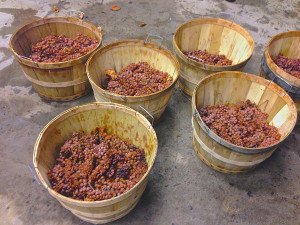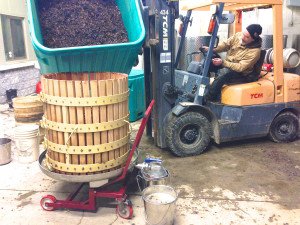Eiswein production in Germany during the 1700s began quite unintentionally when wine grapes froze on the vine before harvest time and winemakers made the frozen grapes into a sweet wine, what we know today as Icewine. Hainle Winery, Located in the Okanagan Valley of British Columbia, was the first winery in Canada to make Icewine beginning in 1972. This was another case of grapes freezing before harvest time and a winemaker trying to salvage his crop. Walter Hainle recalled his family history of Germanic winemaking traditions and with this knowledge set out to produce what became the first Icewine made in North America.
Vidal grapes being emptied into a basket press for juice extraction. Photo credit: C. Silversides
In 1983 both Inniskillin and Trius Winery (formerly known as Hillebrand Winery) began making Icewine in Niagara-on-the-Lake. Over the years many other area wineries started to make Icewine, typically from Riesling and Vidal grapes. Today Canada is the largest Icewine producer in the world, with the majority being made in the Niagara Peninsula wine region of Ontario. In November of 2013 harvesting began for grapes used in Icewine, typical varieties are Riesling and Vidal. There are many stringent rules for the production of Icewine, for instance the temperature has to be -8 degrees Celcius or colder in order to harvest grapes intended for the production of Icewine. During some seasons it is not cold enough long enough for harvesting until February or March. So what happens to grapes that do not make the cut?
 Baskets of Vidal grapes hand-harvested from the Niagara College Teaching Winery vineyard. Photo credit: C. Silversides
Baskets of Vidal grapes hand-harvested from the Niagara College Teaching Winery vineyard. Photo credit: C. SilversidesBaskets of Vidal grapes hand-harvested from the Niagara College Teaching Winery vineyard. Photo credit: C. Silversides
A winemaker might choose to make a Late Harvest wine with those grapes. Vidal was hand-picked this past week by a class at the Niagara College Teaching Winery which is intended to be made into a Late Harvest wine since the temperature was not cold enough to qualify for Icewine. Late Harvest is similar being that it is a sweet wine, but grapes are picked later than grapes used in Icewine. Since the production is not as intensive as pressing and fermenting frozen grapes, the cost is much less. Pair either of these sweet wines with bleu cheese, foie gras, or a dessert that is not as sweet as the wine. Late Harvest and Icewine also make a great dessert on their own. With the early harvesting of Icewine grapes this season, looks like this will be an incredible vintage year for Ontario due to all the grapes harvested. Thinking about Icewine, the Icewine Festival in Niagara-on-the-Lake is running until month-end.
So there you have it: Eiswein, Icewine, Late Harvest
